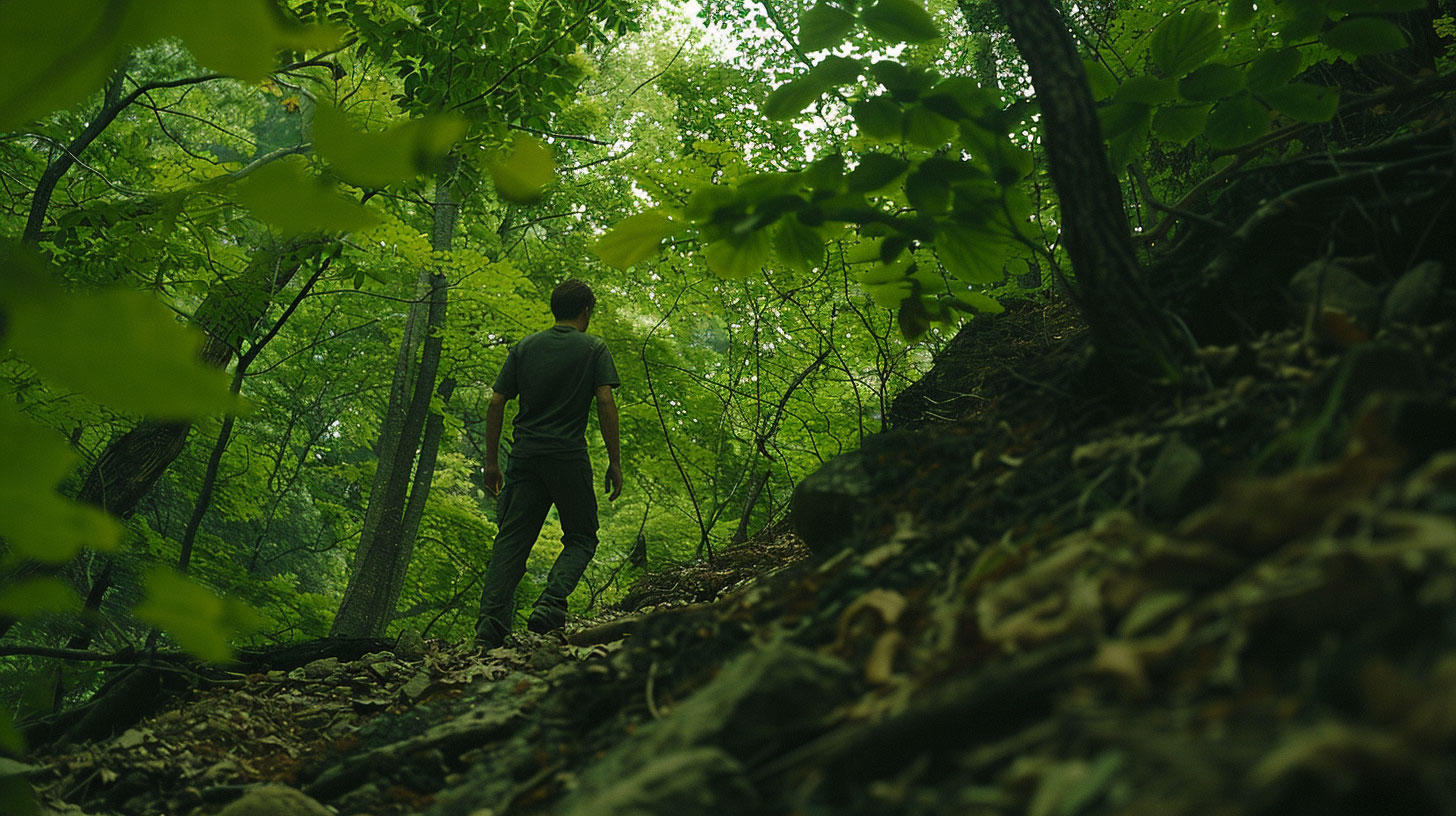Table of contents
Understanding Forest Bathing
In our fast-paced world, finding solace and tranquility is a necessity for maintaining our well-being. Forest bathing, a practice rooted in the heart of nature’s embrace, offers a serene escape. Let’s delve into the origins of this therapeutic practice and uncover the science behind nature’s healing capabilities.
Origins of Shinrin-yoku
The term ‘Shinrin-yoku’ translates to ‘forest bathing’ or ‘taking in the forest atmosphere’ and was first introduced in Japan in the early 1980s. As we learn from National Geographic, the concept was developed by the Forest Agency of Japan as a holistic approach to promote health, wellness, and happiness. The idea was simple yet profound: by immersing oneself in the serene environment of a forest, people could experience therapeutic effects, thus enhancing their quality of life.
This practice quickly became an essential part of Japanese preventive healthcare, encouraging people to reconnect with nature and fostering an appreciation for the outdoors. Today, it’s not only a cornerstone of Japanese culture but also a global phenomenon, as more and more individuals seek out natural retreats to revitalize their mind and body (Environmental Health and Preventive Medicine). Discover more about the practice of shinrin-yoku and its widespread appeal.
The Science of Nature’s Healing
The restorative power of forest bathing is not just anecdotal; it’s backed by a growing body of scientific evidence. Studies have shown that time spent in a forest setting can have measurable physiological effects, such as lowering the pulse rate, reducing blood pressure, and balancing the activity of the nervous system. Specifically, forest environments tend to increase parasympathetic nerve activity, which promotes relaxation, while simultaneously decreasing sympathetic nerve activity, associated with the body’s ‘fight or flight’ response (Environmental Health and Preventive Medicine).
Forest bathing for stress relief isn’t about physical exertion; rather, it’s about connecting with nature through our senses—sight, hearing, taste, smell, and touch. This mindful engagement allows us to unplug from digital distractions, slow down, and immerse ourselves fully in the present moment. The resulting calmness and clarity are just a few of the forest bathing benefits that help to alleviate stress and enhance mood (Time).
By understanding the origins and scientific underpinnings of forest bathing, we can better appreciate the profound impact that connecting with nature has on our health. As we explore the concept further, we’ll discover the various ways to practice and integrate this form of forest therapy into our daily lives, ensuring that the gifts of the forest can be enjoyed by all.
The Practice of Immersion
The practice of immersion through forest bathing, or shinrin-yoku, is a gentle, yet powerful, way to revitalize our minds and bodies. As we step into the forest, we leave behind the hustle of life and enter a world where we can reconnect with nature and ourselves. Let’s delve into the sensory experiences and
Engaging the Five Senses
When we embrace the art of forest bathing for stress relief, we engage all five senses to tap into nature’s serene presence. This multisensory engagement is the key to unlocking the forest’s restorative power:
- Sight: We feast our eyes on the verdant greens of the trees and the interplay of light and shadow, noticing the diverse patterns and textures that nature paints.
- Sound: We listen to the symphony of the forest – the birdsong, the rustling leaves, and the soft whispers of the wind.
- Smell: We breathe in the forest’s fragrance, a fresh, earthy scent that grounds us in the present moment.
- Taste: We taste the purity of the forest air, sometimes catching the essence of nearby streams or the subtle flavor of the woods.
- Touch: We feel the textures of the forest, from the rough bark of trees to the softness of moss, and the coolness of the streams.
This sensory immersion, as described by Time, allows us to slow down and be present, contributing significantly to our relaxation and stress relief.
Mindfulness in the Woods
Mindfulness is at the heart of forest bathing. As we walk slowly and deliberately through the woods, we focus on the present moment, absorbing the tranquility around us. This mindful connection with nature, as highlighted by Silvotherapy UK, is not about the physical exertion of hiking but about experiencing the forest through our senses. It’s about being rather than doing.
In this space of
As we immerse ourselves in the forest atmosphere, we are not on a quest to reach a destination; rather, we are there to soak up the ambiance, making forest bathing a perfect antidote to today’s fast-paced life. The practice invites us to connect with nature in a deep and meaningful way, offering a sanctuary for our overstimulated minds.
For those interested in incorporating this therapeutic practice into their lives, our forest bathing guide provides accessible forest bathing exercises that highlight simple ways to begin. Whether you’re visiting a nearby woodland or seeking forest therapy in urban spaces, the benefits of forest bathing are within reach. Embrace the journey and discover the forest bathing benefits of enhanced mood, creativity, and a profound sense of stress relief that comes with your forest bathing experience.
Physical Health Benefits
When we immerse ourselves in the practice of forest bathing for stress relief, we also open up a world of physical health benefits. Let’s explore how connecting with nature can boost our immune function and lead to lower blood pressure and heart rate.
Boosting Immune Function
One of the most remarkable physical benefits of forest bathing is the enhancement of our immune system’s efficiency. A groundbreaking study in Japan discovered that forest bathing significantly increased the activity of human natural killer (NK) cells, a crucial component of our immune defense against tumors and virus-infected cells (Environmental Health and Preventive Medicine). These findings are attributed to phytoncides, airborne chemicals emitted by trees and plants, which, when we breathe them in during our forest bathing experience, boost our immune function, diminish stress hormones, and elevate anti-cancer protein levels.
Lowering Blood Pressure and Heart Rate
Another key physical advantage of immersion in nature is the calming effect it has on our cardiovascular system. Research indicates that forest bathing can help reduce our pulse rate and lower our blood pressure (MDPI). It also balances our nervous system by increasing parasympathetic nerve activity (which promotes relaxation) and decreasing sympathetic nerve activity (associated with the ‘fight or flight’ response). These physiological changes are vital in alleviating stress and enhancing our mood, contributing to a profound sense of tranquility.
| Physiological Measure | Effect of Forest Bathing |
|---|---|
| Blood Pressure | Decrease |
| Heart Rate | Decrease |
| Stress Hormones | Reduction |
| Parasympathetic Activity | Increase |
| Sympathetic Activity | Decrease |
By embracing mindfulness in nature and the practice of forest bathing, we support our body’s innate ability to heal and maintain balance. As we continue to learn from shinrin-yoku and the global forest therapy movement, we encourage you to take simple steps to integrate these practices into your life. Begin with our forest bathing guide and explore forest bathing exercises that can be easily incorporated into your routine to help in revitalizing both mind and body.
Mental and Emotional Wellness
The practice of forest bathing for stress relief not only has a profound impact on our physical health but also significantly enhances our mental and emotional wellness. Let’s delve into how immersing ourselves in the tranquility of the forest can reduce our stress and anxiety and simultaneously enrich our mood and creativity.
Reducing Stress and Anxiety
When we engage in forest bathing, we step into a world where the hustle and bustle of our daily lives are replaced by the calming whispers of nature. The science supports what we intuitively feel; research has illustrated that forest bathing can lower pulse rate and blood pressure, increase parasympathetic nerve activity, and reduce sympathetic nerve activity, all of which contribute to a more relaxed state of being.
A table summarizing the effects of forest bathing on stress and anxiety is presented below:
| Physiological Effect | Change Observed |
|---|---|
| Pulse Rate | Decrease |
| Blood Pressure | Decrease |
| Parasympathetic Nerve Activity | Increase |
| Sympathetic Nerve Activity | Decrease |
Participants in a forest bathing study reported feeling more comfortable, soothed, refreshed, and natural, with a significant reduction in feelings of anxiety, depression, anger, fatigue, and confusion. By connecting with nature, we allow ourselves to experience the therapeutic effects of phytoncides, natural compounds emitted by trees, which have been linked to reduced stress hormones and increased levels of anti-cancer proteins.
Enhancing Mood and Creativity
Our immersion in the forest not only diminishes stress and anxiety but also cultivates an environment ripe for enhancing our mood and stimulating our creativity. The serene setting allows us to disconnect from electronic distractions and reconnect with our inner selves, fostering a sense of peace and well-being.
The additional benefits of forest bathing include heightened creativity, improved focus and concentration, enhanced energy levels, and increased feelings of happiness (Silvotherapy). These benefits are not confined to forests alone; other natural environments such as parks and gardens can also serve as sanctuaries for our mental and emotional rejuvenation.
| Mental and Emotional Benefit | Outcome |
|---|---|
| Mood | Enhancement |
| Creativity | Boost |
| Focus and Concentration | Improvement |
| Energy Levels | Increase |
| Feelings of Happiness | Increase |
To truly reap the benefits of forest therapy, it is essential to be present in the moment, engaging all our senses to fully absorb the essence of the forest. This mindful approach to forest bathing enables us to slow down, savor our surroundings, and emerge from the forest not only less stressed but also more inspired and connected to the world around us.
By integrating forest bathing into our life, we open ourselves to a holistic approach to health—one that nurtures our body, refreshes our mind, and uplifts our spirit. Whether it’s following a forest bathing guide, participating in forest bathing exercises, or simply allowing ourselves a moment to immerse in nature, we can find solace in the forest’s embrace and return to our lives invigorated and renewed.
Global Forest Bathing Movement
As we delve deeper into the realm of reconnecting with the Earth, we witness a global embrace of shinrin-yoku, or forest bathing, a practice that brings a multitude of benefits for both mind and body. This gentle, meditative approach to being in nature is not just an isolated trend but part of a wider movement that spans across continents.
Shinrin-yoku Around the World
The concept of Shinrin-yoku, which originated in Japan, has blossomed into a worldwide phenomenon. Recognizing the profound effects that forest bathing has on stress alleviation, countries around the globe are promoting the practice as a form of mindful travel. Travelers now seek natural sanctuaries to experience the therapeutic embrace of the woods, engaging in forest bathing exercises that rejuvenate the spirit.
It’s inspiring to see how an ancient practice has found its way into modern life, allowing us to rediscover the art of connecting with nature. With urbanization on the rise, and projections that 66% of the world’s population will reside in cities by 2050, the need for forest bathing is more crucial than ever (Time).
Forest Therapy in Urban Spaces
We can’t ignore the stark statistic that the average American spends 93% of their time indoors. This disconnection demands creative solutions, and forest therapy offers a bridge back to nature, even within the confines of urban environments (Time).
Natural spaces such as city parks, gardens, and even smaller pockets of greenery can serve as oases for forest therapy. These urban sanctuaries are integral in providing citizens with accessible ways to engage in mindfulness in nature, offering respite from the concrete jungle.
Forest bathing in urban settings can include a variety of activities, from guided walks to
We stand at a pivotal moment where integrating nature into our daily lives is more than a luxury—it’s a necessity. As we continue to champion the forest bathing movement, it is our hope that more individuals will discover the solace found within nature’s embrace, whether it’s through a weekend forest bathing experience or a brief respite in the nearest park. Let us carry the spirit of the forest with us, no matter where we roam, and let the healing power of nature touch our lives.
Integrating Forest Bathing into Life
For those of us passionate about wellness and sustainability, integrating forest bathing into our lives can be a serene and transformative practice. It’s not only about finding solace in the forest; it’s about bringing the essence of shinrin-yoku into our daily routines. Let’s explore how we can begin this journey and make time for nature even amidst our busy lives.
Simple Steps to Begin
Embarking on the path of forest bathing doesn’t require a grand forest or distant wilderness. Any natural environment with trees can be the perfect setting to start. Here are some simple steps to begin your forest bathing experience:
- Identify a local park, garden, or natural space with trees. Even urban green spaces can offer a sanctuary for connecting with nature.
- Allocate a specific time in your schedule for visiting this space. It could be as little as 15 minutes on a lunch break or a longer session during the weekend.
- Leave behind your digital devices to fully immerse yourself in the experience. It’s a time to unplug and unwind.
- Embrace mindfulness by focusing on your breath, the sounds around you, and the feeling of the earth beneath your feet. It’s not about exercise but about being present.
- Engage all your senses. Listen to the rustling leaves, inhale the scent of the soil, and feel the texture of tree bark (Silvotherapy).
By integrating these simple steps into our routine, we pave the way for a deeper connection with our environment and ourselves. Forest bathing isn’t just a one-time activity; it’s a lifestyle shift that encourages us to embrace the healing power of nature regularly.
Making Time for Nature
In today’s fast-paced world, making time for nature is more crucial than ever. Studies indicate that spending just two hours in a forest or natural setting can significantly impact our health, allowing us to enjoy the calming sounds, smells, and sights that nature offers (Time).
Here’s how we can make time for nature:
- Prioritize nature time as you would any important appointment. It’s an investment in your well-being.
- Integrate short walks or forest bathing exercises into your daily routine, whether it’s a morning ritual or an evening unwinding activity.
- Plan nature engagements on the weekends, such as longer walks or picnics in a park. This can be a social activity or solitary retreat, depending on your preference.
- Consider active commuting if possible, such as walking or biking through areas with trees and greenery.
- Join community groups focused on nature activities or forest therapy, which can provide a structured way to enjoy the outdoors.
Remember, the goal is not to add another ‘to-do’ on our list but to find joy and tranquility in our interactions with the natural world. By 2050, with an estimated 66% of people living in urban areas (Time), the practice of forest bathing is not just beneficial but essential for maintaining our connection to the earth and our own mental and physical health.
Incorporating forest bathing into our lives is a gentle reminder to slow down and savor the moment. As we embrace the trees and breathe with the forest, we find that the greatest gifts are often found in the simplicity of nature’s embrace. Let’s step outside and allow ourselves to be revitalized by the therapeutic beauty that surrounds us.
FAQs (Frequently Asked Questions)
Forest bathing, or Shinrin-yoku, originated in Japan in the 1980s as a practice of immersing oneself in the forest atmosphere for health and wellness benefits. It emphasizes connecting with nature through all five senses without the need for physical exertion.
Scientific studies indicate that forest bathing can lower pulse rate, reduce blood pressure, balance nervous system activity, boost immune function, and decrease stress levels. It engages the senses in a way that promotes relaxation and
Forest bathing is accessible and beneficial for people of all ages and fitness levels. It emphasizes a personal and sensory connection with nature, making it a universally inclusive practice.
To begin, find a natural space where you can be present and undisturbed. Leave digital devices behind and focus on engaging your senses with the environment. Simple, mindful walks, where you absorb the sights, sounds, and smells of nature, are a good start.




